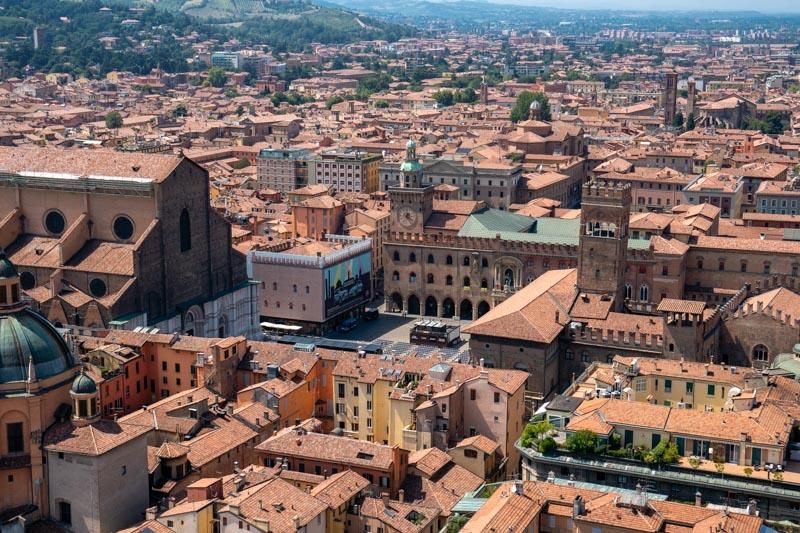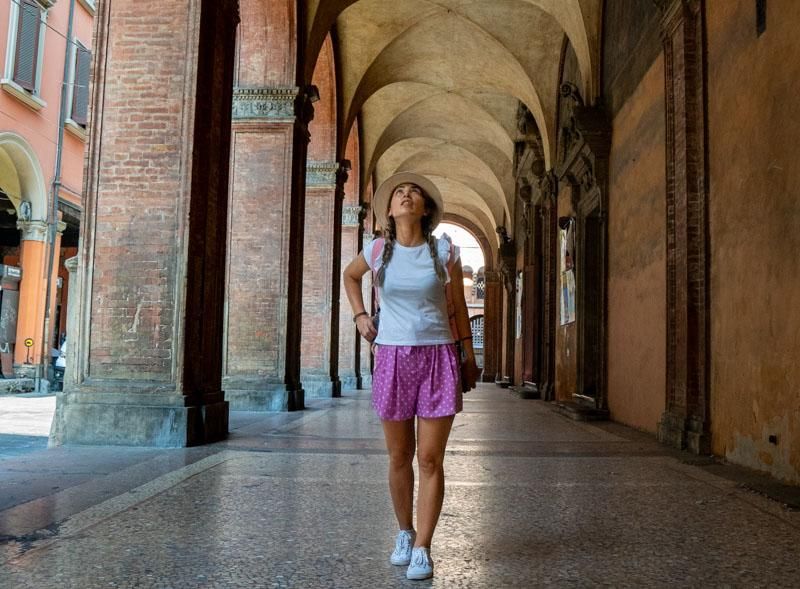The city of Bologna is the capital of northern Italy’s Emilia-Romagna region. The city is located less than an hour inland from Italy’s east coast and midway between the cities of Milan and Florence.
Bologna is a university city, and its 11th century the University of Bologna is the western world's oldest university. The city has lavish walkways complete with porticoes, several wonderful historic buildings and an interesting medieval centre. Bologna is also famous for its food, the region is considered to be the best food-producing area of Italy and this is reflected in Bologna having the nickname of La Grassa, or the ‘fat one’.
This post contains affiliate links and if you click one I may receive a small commission at no extra cost to you.
How to get to Bologna
Transportation into Bologna is never a problem since Bologna’s international airport is only 9 km from the city centre with direct flights from London and other major European cities.
Bologna is considered a regional transportation hub with excellent access to the cities of Milan, Venice, Florence and Rome as well as both the east and west coasts. The historic city centre is just a few minutes walk from the train station or you can take a bus.
Driving to Bologna from Milan, Venice, Florence and other towns in Emilia Romagna is also an option. We visited Bologna during our Italian road trip in the summer. There is paid public parking just outside the city centre.

The majority of the historic centre of the city is fairly compact and closed to traffic, making it an ideal place for strolling around.
What to do and see in Bologna
Bologna is not as busy as other major Italian cities, which makes it a perfect destination to feel more like a local than just a tourist. This city has a lot to offer to its visitors, no matter what you are interested in, there is always something for you to do.
Admire the beauty of historical porticoes
Bologna is known as the city of porticos. The portico is the main architectural feature of this city.
Taking into consideration only the historical area of the city within the 13th-century city walls, this area contains more than 38 km of enclosed walkways with unique arches and columns. If counting the porticos outside the centre, this reaches a total length of 53 km.
They first appeared in the 11th century as overhanging upper stories of buildings in the city centre by creating more space in the growing city. As these became larger, they needed support beams and posts and the arcades grew.

By the 13th century, a law was passed that they should be high enough to allow a rider on horseback to pass beneath.
Bologna is also home to the world’s longest portico, the Portico di San Luca, being 3.5km long and leaving the city centre to the Sanctuary of the Madonna di San Luca. This portico has 666 arches and rises into the hills, offering an enjoyable walk for many people, particularly on Sundays.
Stroll around Piazza Maggiore and Piazza del Nettuno
These two adjoining squares seem to be one of the main places for friends to meet up in the centre of the city. The sounds of conversation and laughter blend well with the splashing water from the Neptune Fountain which gives the Piazza del Nettuno its name.
The fountain was designed by the architect Giambologna in the 16th century, it is one of the finest fountains of its period and a symbol of the city.

Nearly every attraction to be viewed in Bologna is within a few minutes walk of these two squares including the busy shopping street of Via dell’Indipendenza and the Via Galleria, full of aristocratic mansions.
On one side of the Piazza Maggiore is the Basilica of San Petronius, on the northern side is the former Governors Palace (Palazzo del Podesta) and the Torre dell’Arengo dating from 1259.
Visit Basilica di San Petronio
Basilica di San Petronio is the sixth largest church in Europe. Construction of this massive church began in 1390 and it was planned to be larger than St. Peter’s in Rome. In fact, it never exceeded those expectations and as never finished with an incomplete facade remaining today.

In the museum at the back of the church are the designs that were submitted for completion by the architect Andrea Palladio. The completed interior has been described as the epitome of Gothic architecture. The side chapels each look like a small church and the meridian line runs across the floor of the nave.
Climb the Asinelli Tower
Without any doubt, the most famous leaning tower is the one in Pisa but Bologna’s pair of leaning towers appear to tilt more precariously due to their narrower shape.
There were around 180 towers in Bologna but only 22 of them survived. The two towers of Garisenda and Asinelli are one of the main attractions in the city. They were built in the 12th century as watchtowers and places of refuge in case of an attack, although they also became known as the symbol of Bologna.

The 48 metres high Torre Garisenda leans by more than 13 metres and it is not open to the public, but if you are ready to take 498 steps in steep wooden staircases, you can go to the top of the Asinelli Tower and have a 360 view of the city.
The entrance fee is only €5 and you can purchase it online.
Explore Piazza del Mercato
The historic Piazza del Mercato is a huge open space in the centre of the city and home to the street market since at least the 13th century.

Another historic must-see spot in the city is the Quadrilatero. This medieval market hosts several Bolognese culinary specialities including several varieties of stuffed pasta, meats, cheese and local wine.
There are also some restaurants and bars in the area.
Stroll through Basilica Santo Stefano
There is no shortage of interesting churches across the city of Bologna and many of them are filled with art. The Basilica Santo Stefano, which is also known as "Complex of the Seven Churches”, is a complex of several buildings including churches, cloisters, tombs and courtyards.

The buildings were built by the Benedictine monks from the 10th through to the 13th centuries. These buildings contain the remains of Bologna’s early martyrs, Saints Vitale and Agricola. The principal church, Chiesa del Crocifisso contains a 12th-century external pulpit and a crypt dating from the year 1019. The octagonal-shaped Santo Sepolcro opens onto a pillared courtyard and contains various styles from previous Roman and Byzantine buildings including a 6th-century mosaic floor.
Here is a peaceful place to walk and admire the religious art and artefacts.
Take photos of Bologna’s hidden Little Venice
Bologna might be very different from Venice with its 118 islands, but it has several canals with a 60 km network dating back to the 12th century.

In the past, the goods were transported through these canals which are also known as La Piccola Venezia (the Little Venice). Gradually, as the city developed the canals became hidden. However, there are still a few spots where you can see the remaining canals and take pictures of them.
Visit the old anatomy classroom
The Anatomical Theatre of the Archiginnasio, founded in 1088, was once the main building of Bologna’s university, but later in the 17th-century, it became an anatomical lecture hall.
Here is where you can go travel back in time and sit around the marble table where medical students learned anatomy by watching corpses being dissected.
The hall is also extremely beautiful and well decorated. Unfortunately, the building was destroyed during the Second World War, but it was rebuilt by using its original pieces.

Visit Oratory of Battuti
By climbing the stairs above the church visitors will find one of Bologna’s unsung treasures. This small oratorio is decorated in Baroque paintings, frescoes and gilded carvings. Use the benches to gaze up at the ceiling.
Around the room are a group of 15 terracotta statues known as ‘Death of the Virgin’ created in the early 16th century. The room has excellent acoustics and musical programmes are on occasion held here. Since it was founded in the year 910, the Cathedral of San Pietro has undergone several changes, a choir was added in 1575, and a remodelled nave in a Baroque style in the 17th century. There is a collection of artistic treasures donated over several centuries including items belonging to former popes and a processional cross given in 1996.
Explore Bologna National Gallery
Bologna National Gallery’s main aim is to preserve and display works by artists who have lived and worked in Bologna or anywhere in the region of Emilia Romagna from the 13th through to the early 19th centuries.
Some works have an extensive history of their own, with others being rescued from churches that have closed down or been turned into other uses. Some works were returned to Bologna after Napoleon took them to the Louvre in Paris.
San Luca Sanctuary
About 3.5km from the centre of Bologna, the Basilica of Saint Luke is one of the most beautiful religious buildings of Italy. It occupies a wonderful position overlooking the city below.

San Luca Sanctuary which sits 300 metres above sea level at the top the Colle della Guardia hill, has been the symbol of Bologna for centuries.
You walk on the world’s longest covered walkway from the city centre to the San Luca Sanctuary. If you don't fancy walking around 4 km up, you can drive or get a taxi instead.

Eat good food in Bologna
Bologna is a heaven for foodies. This city offers some of the best Italian dishes including handmade egg pasta, stuffed pasta, especially tortellini. The famous delicious Italian Bolognese sauce is typically from this city, so while in Bologna try Tagliatelle Al Ragù and Lasagna Bolognese. Bologna is also known for its salami, ham and cheese.

Tortellini
Bologna’s association with its stuffed pasta began with its tortellini and the slightly bigger tortellini which are still handmade today in the pasta shops, known as sfogline. Another variation is the oversized tortellacci. While these variations of stuffed pasta are covered with a sauce or added to soups, the traditional way is that they are served in a broth, known as brodo.
Lasagna
Lasagna, Bologna style may be very different from what you are used to eating. The full flavour creamy bechamel sauce covering the bolognese sauce and sheets of lasagna pasta makes this dish one to remember.

Meats and Cheese
Mortadella served in the oldest market in the city, the Quadrilatero tastes very much of pork and garlic. At the market, you can try before you buy to ensure you like the taste.
Prosciutto ham is actually more native to the neighbouring city of Modena and is one of the amazing flavours of the region. It is tender, with a touch of a salty taste. An alternative is a fattier version known as Speck. Parmigiano Reggiano is one of Bologna’s most famous cheeses, it takes years to produce and age and is known as the ‘king of cheese.’




